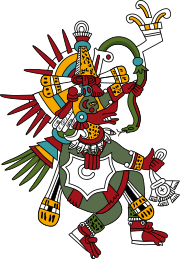Huehueteotl

Huehueteotl /ˌweɪweɪˈteɪoʊtəl/ WAY-way-TAY-oh-təl; Nahuatl pronunciation: [weːweˈteoːt͡ɬ] is a Mesoamerican deity figuring in the pantheons of pre-Columbian cultures, particularly in Aztec mythology and others of the Central Mexico region. The spellings Huehuetéotl and Ueueteotl are also used. Although known mostly in the cultures of that region, images and iconography depicting Huehueteotl have been found at other archaeological sites across Mesoamerica, such as in the Gulf region, western Mexico, Protoclassic-era sites in the Guatemalan highlands such as Kaminaljuyú and Late-Postclassic sites on the northern Yucatán Peninsula (Miller and Taube, 1993:189). The name Huehueteotl, from Nahuatl huēhueh ([ˈweːweʔ]) "old" and teōtl ([ˈteoːt͡ɬ]) "god".
Huehueteotl is frequently considered to overlap with, or be another aspect of, a central Mexican/Aztec deity associated with fire, Xiuhtecuhtli. In particular, the Florentine Codex identifies Huehueteotl as an alternative epithet for Xiutecuhtli, and consequently that deity is sometimes referred to as Xiutecuhtli-Huehueteotl.

However, Huehueteotl is characteristically depicted as an aged or even decrepit being, often with a beard, whereas Xiutecuhtli's appearance is much more youthful and vigorous, and he has a marked association with rulership and (youthful) warriors.[1][2]
Worship
An Aztec religious observance was celebrated via boys hunting small animals such as snakes, lizards, frogs and even dragonfly larvae in the swamps to give them to the elders who served as the guardians of the fire deity. As a reward for these offerings, the priest would give them food. At these occasions the god was demonstrated as young with turquoise and quetzal feathers for ceremonial purposes. Later during the month he appeared as aging and tired, covered with the colours of glow; gold, black and red. Perhaps this has led to the confusion of the deity being two separate ones, as being displayed as such, or vice versa.
Another, more dramatic, one was a celebration consisting of feasts and a time of ceasing hostilities. The Aztecs cut out the hearts of human sacrifices, followed by burning them on coal. As a result of this, the people would regain Huehueteotl's favour through the god's elements — fire and blood.
References
- ↑
- Miller, Mary; Karl Taube (1993). The Gods and Symbols of Ancient Mexico and the Maya. London: Thames and Hudson. ISBN 0-500-05068-6.
- ↑ Birmingham Museum of Art (2010). Birmingham Museum of Art: Guide to the Collection. London, UK: GILES. p. 86. ISBN 978-1-904832-77-5. Retrieved 2011-07-19.
External links
![]() Media related to Huehueteotl at Wikimedia Commons
Media related to Huehueteotl at Wikimedia Commons
